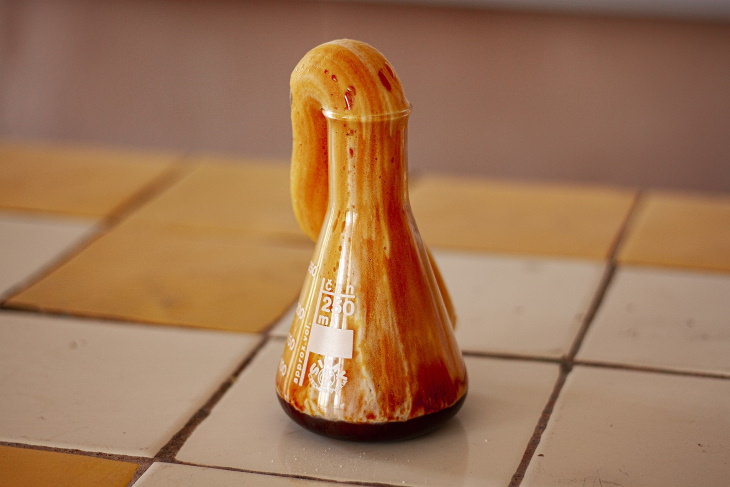
Explosions, color-changing elements, invisible ink - we sure do miss all the fun chemistry experiments we used to do at school. Too bad we can’t do any of them without an actual school lab and safety goggles, or can you?
Combine entertainment with education by conducting a fun science experiment yourself. Best of all, this fun activity is absolutely safe to do at home with kids. It’s called “elephant toothpaste,” and you don’t need any special equipment or supplies to conduct it.

Elephant toothpaste is neither toothpaste nor does it have anything to do with elephants. This science experiment produces a dense colorful foam that fizzes out of a bottle and kind of looks like a big fountain of toothpaste coming out of a tube.
This active chemical reaction occurs when hydrogen peroxide (H₂O₂) is rapidly broken down into oxygen and water. To make it work, you need something to speed up the reaction - a so-called catalyst. For this experiment, we can use regular dry yeast as a catalyst, as it contains something called catalase that will speed up the reaction considerably. For extra sturdy foam, you’ll also need to add a few drops of dish soap, as well as some food coloring to make everything look prettier and more toothpaste-like.
One important thing to note here - the more concentrated the hydrogen peroxide, the fizzier the reaction. Hence, many online recipes recommend using a 6% hydrogen peroxide instead of the 3% kind.
The ingredients and equipment you’ll need to make elephant toothpaste are:
Step-by-step instructions:
1. Pour the hydrogen peroxide into the plastic bottle. We suggest doing this on a tray, or a nylon tablecloth.
2. Drop food coloring onto the sides of the bottle to create toothpaste-like streaks as the foam starts fizzing.
3. Add the dish soap to the bottle and swirl the bottle gently to mix in the dish soap.
4. In the small bowl, combine the yeast with the warm water.
5. Quickly pour the yeast mixture into the plastic bottle, too. Then step back and watch foam go.
NOTE: Elephant toothpaste generates some heat - it’s an exothermic reaction. Therefore, avoid touching the bottle and the foam.
Clean up the foam while wearing rubber gloves, as any leftover hydrogen peroxide may cause skin irritation.
H/T: Mental Floss

35 Small Gestures Kids Truly Appreciate
To help your child feel good about themselves at any age and to show them how much you love them, we’ve gathered 35 small and simple gestures that will help you create a warm and loving relationship.

How to Prepare Kids Starting at a New School
we've divided our tips into three parts: before, during, and after the transition, to help your children prepare and adapt to new environments more smoothly.

7 Styles of Parenting: Is Yours Among Them?
We explore the seven main styles of parenting and how each one may affect children.

What is the Difference Between Asperger's and Autism?
In the following article, you will understand what it is, get to know the main syndromes on the broad spectrum of autism and related terms, and learn whether there is a difference between autism and Asperger's syndrome.

Guide: When to Allow Children to Use Beauty Products
Let's understand when your children can (and maybe should) start using cosmetic products and what they can incorporate into their skincare routine according to their age.

A Guide for Buying Toys for Kids by Age
Here is our guide to buying children's gifts by age.

Nine Ways Using a Smartphone is Harming Your Child
we have gathered for you the 9 problems that may result from prolonged use of smartphones by your child.

9 Things Every Loving Mother Does for Her Children
The following 9 things clarify exactly how much mothers do for their children without them always being aware of it... ..

How to Handle 6 Frustrating Relationship Situations
We've gathered 6 particularly frustrating issues in relationships and some tips to help you solve the problems you’re experiencing – no matter which side you're on.
 3:13
3:13
Dads Being Dads: A Celebration of Some Adorable Fathers
These heartwarming dad moments will brighten your day.

7 Styles of Parenting: Is Yours Among Them?
We explore the seven main styles of parenting and how each one may affect children.

Worn-Out-Mother Syndrome: What You Need to Know
what exactly causes Worn-Out-Mother Syndrome, 8 signs , and what you should do to get back on track and deal with it successfully.

13 Fun Activities That Help Babies Develop Properly
In the first weeks of life, your baby will usually be busy sleeping and eating. to add some excitement to this routine, do these 13 activities!

Most Parents Really Regret Making These Parenting Mistakes
For a little extra help for the always-busy parent, we compiled 10 common parenting mistakes and their fixes according to developmental psychologists.

The Hidden Impact of Growing Up with an Eggshell Parent
Were you were raised by an eggshell parent? Watch out for these signs.

What to Teach Your Children About Love
Nine lessons every parent should teach their children about love.

The Grandparent-Grandchild Relationship is Vital to Kids
A lot of research has recently been concluded showing why the relationship between grandparents and grandchildren is of vital importance. Read on for more.
 11:35
11:35
Keep Kids Entertained This Summer with Cute Paper Toys
This video will show you how to make beautiful ballerina and angel figurines, 3D paper ball and much more!

How to Solve These 5 Common Marital Crises
Sooner or later, each couple undergoes one crisis or another that is inevitable. The good news is that we've put together the ways of dealing with them!

9 Psychological Parenting Tips That Parents Should Know
Raising kids isn't an exact science since every kid is unique, however, these 9 tips can help you in the most general of situations that all families experience.

40 Sentences Every Child Needs to Hear to Succeed in Life
Help your child succeed in life with these 40 sentences.

Important: How to Tell if a Child is Being Bullied!
Know a child who is being bullied or is doing the bullying? Read through this guide.

16 Pictures of Family Love that Will Move You to Tears
A collection of moments shared online that show family at its very finest and most loving

Help Strengthen Your Child's Immune System With These Tips
As parents, we’re always concerned about cold and flu season. Learn how to identify signs of a weak immune system, and 10 ways to strengthen it.

How to Practice Self-Care When Supporting a Sick Spouse
we decided to help you with 8 expert tips, each of which will help you cope with the changes life has brought to your relationship with an ill partner.

15 Answers to Questions That Can Save Your Child's Life
Teaching your children the answers to these 15 questions could save their lives one day.

30 Ways to Bring More Play to Children's Lives
Whether you’re a parent, a grandparent or a teacher - here are 30 simple ways to bring more play into children's lives.

24 Coloring Pages for Kids Who Love Outer Space!
24 fun and free coloring pages for kids who love science and to color!

10 Life Lessons We Should Pass to Our Children
Slowly, these lessons will sink into your child’s mind and change the way they think about themselves and see the world.

7 Routine Breaking Indoor Activities For Kids
Here are 7 screen-less indoor activities you can do with the children to create some good long-term memories.

How to Get Your Baby to Sleep Through the Night
Is your baby having trouble sleeping through the night? These tips will help.

19 Stories Proving Once Again Grandparents Are Awesome
The presence of loving grandparents in one's life is certainly one of life’s most precious gifts, and these heartwarming photos prove it!

The Many Ways Children Benefit From Playing Instruments
Most children are naturally drawn to musical instruments, and once you learn the advantages of playing an instrument you'll be running to get them a guitar!

Disney Has Taught Me a Lot Over the Past Century...
Disney has taught me so much over the years...

The Reason Why Children Misbehave Around Mom
The kids were perfectly calm and behaved like angels - until their parents show up. Here's why kids tend to misbehave the most around mom.
 2:00
2:00
1 Child is a Handful, But 6? This Superdad Handles It!
In this adorable video you will see how one dad takes on six children, aged 4, 3, nearly 2 and 10-month-old triplets at bedtime.

Prevent Children from Developing a Negative Body Image
In the following article, you will learn how to do this correctly and ensure a healthier and happier future for your children.

Introducing the Tibetan Method of Raising Children
A unique method of raising kids inspired by the Tibetans.

Improve Your Child's Life By Teaching Them These 15 Things
15 important insights about approach, effort, and the importance of choosing friends, and many more essential things that your children should know.

17 Parenting Shortcuts to Make Life with Kids Easier
These parenting hacks will make your days a lot less tiring.

Learning From Animals: The Animal Kingdom Parenting!
Do you listen to your gut when it comes to relationships and family? If you don't, you might want to start. Here's how...

The Small Words That Will Change Your Relationship Forever
tips to help you improve the compliments you give your partner, along with 20 examples of compliments you can start giving right now.
 7:59
7:59
How Your Childhood Affects You Throughout Your Life
Learn all about how your childhood affects you as an adult in this brilliant video from the School of Life.

10 Tips to Fix the #1 Mistake Leading Couples to Break Up
This article gives tips on how to avoid the kinds of arguments couples have that lead to breakups.

A Guide for Buying Toys for Kids by Age
Here is our guide to buying children's gifts by age.

How to Handle Complaints in a Relationship
Discover a winning formula to turn complaints into something that strengthens your romantic connections.

15 Wonderful Quotes That Perfectly Describe Grandparents
These beautiful quotes and sayings remind us once again how wonderful a role grandparents play in our lives.
To enable your Ad-Free Subscription, please fill the fields below
Your subscription was successful, now you can enjoy an ad-free experience!! Note: To make sure you get no ads, please make sure to log in to your account. If you are logged in already, then refresh the page. The subscription can be cancelled at any time.


